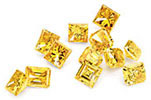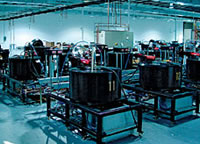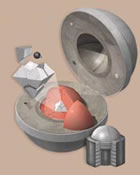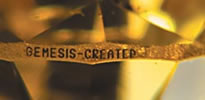Artificial diamond is diamond produced through chemical or physical processes in a laboratory. Like naturally occurring diamond it is composed of a three-dimensional carbon crystal. Artificial diamonds are also called cultured diamonds, manufactured diamonds, and synthetic diamonds.
History
Artificial diamonds were first produced on February 16, 1953 in Stockholm, Sweden by the QUINTUS project of ASEA, Sweden’s major electrical manufacturing company using a bulky apparatus designed by Baltzar von Platen. Pressure was maintained within the device at an estimated 83,000 atmospheres for an hour. A few small crystals were produced. The discovery was kept secret.
 Nevertheless, General Electric researchers reported their own successful diamond synthesis in Nature. The production of smaller artificial diamonds and especially diamond dust has become an important industry with General Electric at the forefront. General Electric, along with Sumitomo Electric and De Beers marketed their synthetic stones as heat sinks for electronics and used them solely for research purposes. Significantly, the majority of these artificial diamonds are not of gem quality.
Nevertheless, General Electric researchers reported their own successful diamond synthesis in Nature. The production of smaller artificial diamonds and especially diamond dust has become an important industry with General Electric at the forefront. General Electric, along with Sumitomo Electric and De Beers marketed their synthetic stones as heat sinks for electronics and used them solely for research purposes. Significantly, the majority of these artificial diamonds are not of gem quality.
As of 2004, two companies have introduced high-quality artificial diamonds to the general market.
 While visiting Moscow in 1995 someone asked Carter Clarke if he wanted to buy a diamond making machine. He brought the machines and the scientists to Sarasota, Florida and started the first diamond making company, Gemesis. Gemesis grows diamonds in high-pressure, high-temperature crystal growth chambers that resemble washing machines.
While visiting Moscow in 1995 someone asked Carter Clarke if he wanted to buy a diamond making machine. He brought the machines and the scientists to Sarasota, Florida and started the first diamond making company, Gemesis. Gemesis grows diamonds in high-pressure, high-temperature crystal growth chambers that resemble washing machines.
The device bathes a tiny sliver of natural diamond in molten graphite at 1500 °C and 58,000 atmospheres. This produces a 2.8-carat rough diamond which can be cut to 1.5 carats.
 Gemesis diamonds have a yellow tint which is rare in natural diamonds and therefore a valuable aesthetic trait. The yellow tint occurs when less than five out of each 100,000 carbon atoms in the diamond crystal lattice are replaced with nitrogen atoms. Technically it is a contaminant, but colored diamonds can still be sold for more money because they can be made more quickly, they cost less to manufacture, and they are very popular.
Gemesis diamonds have a yellow tint which is rare in natural diamonds and therefore a valuable aesthetic trait. The yellow tint occurs when less than five out of each 100,000 carbon atoms in the diamond crystal lattice are replaced with nitrogen atoms. Technically it is a contaminant, but colored diamonds can still be sold for more money because they can be made more quickly, they cost less to manufacture, and they are very popular.
A second company, Boston, Massachusetts based Apollo Diamond, uses the low-pressure technique of chemical vapor deposition Chemical Vapor Deposition (CVD) to produce larger, less expensive diamonds with greater control over impurities. The diamond produced is a single crystal, as opposed to the polycrystalline patchworks formerly produced by CVD.
This greater measure of control allows Apollo Diamond to produce diamonds of various colors including colorless, pink, blue, honey brown, and even black. The ability to control the intentional introduction of impurities, doping, is necessary for the creation of diamond semiconductor devices.
Uses
The CVD produced diamonds have been targeted for their potential use in technology. For example, University of Wisconsin, Madison chemistry professor Robert Hamers has developed a photochemical method for covalently linking DNA to the surface of polycrystalline diamond films produced through CVD. Also, the diamonds have been shown to detect redox reactions that can’t ordinarily be studied and in some cases degrade redox-reactive organic contaminants in water supplies.
The artificial diamonds also have potential uses in the semiconductor industry. This is because the diamonds can be “doped” with impurities like boron and phosphorus. Since these elements contain one more or one less electron than carbon, they turn the diamonds into n-type or p-type semiconductors. There are also studies being conducted about impregnating boron-doped CVD diamonds with deuterium yields to produce n-type semi conducing diamonds.
 Both types of diamonds mentioned above are visually indistinguishable from the naturally occurring ones. However, the companies have taken steps to ensure that they can be distinguished by laser inscription, trace impurities, and infrared and X-ray spectroscopy.
Both types of diamonds mentioned above are visually indistinguishable from the naturally occurring ones. However, the companies have taken steps to ensure that they can be distinguished by laser inscription, trace impurities, and infrared and X-ray spectroscopy.
The diamonds are being marketed at $4,000 per carat, or roughly 30% less than the price of a comparable natural diamond. The traditional diamond industry is evaluating countermeasures to these cheaper alternatives.
 Most artificial diamonds are less than one carat in the rough. Since 30% to 70% of the rough material is removed during cutting, the majority of created diamonds end up as less than full carat faceted stones. However, the growers have recently started producing rough stones in 3-carat sizes and we expect to see more full carat (and larger) cut diamonds in the market in the future.
Most artificial diamonds are less than one carat in the rough. Since 30% to 70% of the rough material is removed during cutting, the majority of created diamonds end up as less than full carat faceted stones. However, the growers have recently started producing rough stones in 3-carat sizes and we expect to see more full carat (and larger) cut diamonds in the market in the future.
Nearly all artificial diamonds are an intense yellow-orange fancy color, due to nitrogen introduced during processing. They are very pretty but the diamond market is greater for near colorless diamonds so the growers are working on techniques to produce near colorless and ultimately colorless.
Clarity can be as high as GIA rated VS1 in artificial diamonds. Therefore it is becoming increasingly important to deal with diamonds having AGS or GIA certifications to protect your diamond buying decisions.
